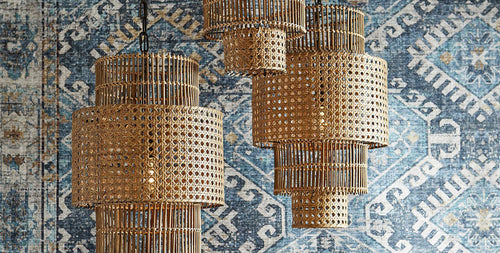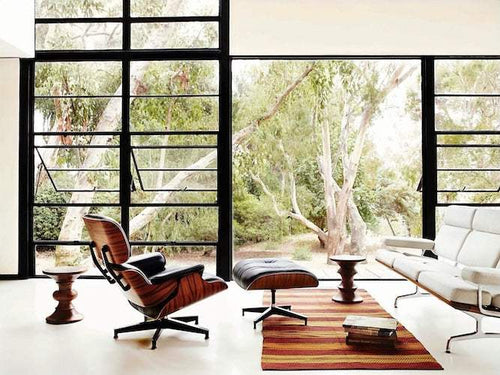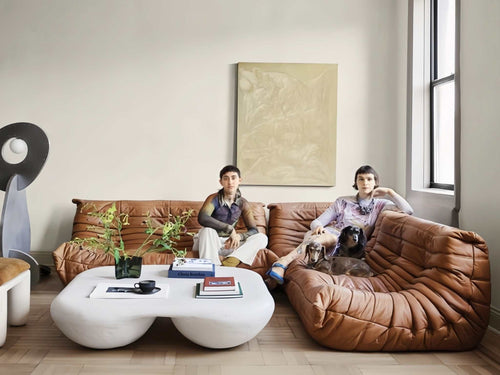First popularised by Rachel Ashwell's slipcovered furniture, this decorating style evokes an elegant yet relaxed sense of timelessness. It's a style that suggests furnishings were put into place decades, or even a century, ago and left to fall into picturesque decrepitude since then.
It typically involves trawling markets and second-hand stores for items that can be repainted or re-covered. Pale pastel colours are a key element, as are weathered wood and soft textures.
How to Shabby Chic Furniture
Shabby chic furniture often takes the form of preloved pieces. These can be painted in soft hues like white, cream, or light stormy grey undertones. Feminine floral patterns are also popular, and slipcovers are a classic touch. Another way to achieve this look is to apply applique images of ferns, birds, or flowers to the surface of a piece. These can be purchased from second-hand bookshops and then glued on with PVA glue. To make the colours of these appliqués blend in with the background colour, paint the surface with a watered-down layer of your top coat shade and then wax over it once it's completely dry.
Unlike vintage items that may be authentically old and have been used over the years, shabby chic furniture is typically newer but intentionally aged-looking. This might be done with sanding, staining,, and other special techniques. It's also common to see rust and paint chips on vintage-style furniture.
While some shabby chic decor might have a reputation for being "granny-like," many designers are masters of creating elegant, sophisticated pieces that still feel welcoming and approachable. For example, a lace runner layered over a distressed nightstand with soft floral details and golden decor would make a beautiful statement piece in a bedroom. Add in a sheepskin floor rug and luxurious bedding to finish the room off.
Shabby Chic Interiors
Shabby Chic embraces the idea of recycling and repurposing older furniture. The style also incorporates a more feminine appearance in home decor and accent pieces. It's often expressed through floral motifs, linen bedding, and delicate lace and filigree details. It's also seen in the colour palette of whites and light pastel shades, like dusty pink, lavender, and sky blue.
Flea market finds, secondhand stores, and thrift stores are a great source of vintage and rustic decor items. These items are typically weathered and well-used, displaying character that is quintessential to the shabby chic aesthetic. The style also aims to keep rooms clean and uncluttered. Too much dark or heavy decor can detract from the breezy, shabby chic look.
Fabrics like cotton, muslin, and linen provide the perfect backdrop for shabby chic. The fabrics are usually textured and have a vintage feel to them. The style is known for its romantic mood, so floral prints are a must. They are often found on bed sheets, throw pillows, and linen slipcovers for lounge seating.
Natural elements like pressed flowers and feathers are also essential elements of the shabby chic style. Displaying these in rustic containers, such as a glass bottle or wooden tray, can add to the charm of the room. Metallic colours are also an important aspect of this style, as they help to balance the shabby with the chic.
Shabby Chic Bedrooms
For bedrooms, shabby chic design ideas offer a cosy retreat with plenty of personality. Unlike the overcluttered style of the 1990s, shabby chic bedroom decor today emphasises light neutral colours with soft floral accents for an inviting ambiance. The bed is usually the focal point, and duvets, quilts, and comforters decorated in white or other soft shades are common bedding choices.
Ruffled curtains, lace bedskirts, and throw pillows in floral or striped patterns help establish a shabby chic bedroom motif. Vintage fabrics like tulle and lace add a touch of romance, while antiques and repurposed items give your bedroom an antiquated feel. Decorative elements that hint at a past time, like cross-stitched and embroidered fabrics displayed in vintage frames and pressed flower wall art, are ideal for a shabby chic bedroom.
Shabby chic bedroom furniture often has a distressed finish that adds character to the piece. Look for scuffed or scratched edges and visible knots in the wood to find pieces that reflect this decorating trend. To keep the look from becoming too rustic, choose wood finishes in softer hues, such as whitewashed or grey-painted furnishings. To make shabby chic more visually appealing, pair distressed pieces with other contemporary touches, like a tufted accent chair and sheepskin floor rugs.
Shabby Chic Living Rooms
To bring a touch of shabby chic into a living room, consider light neutral colours for walls and floors. Crisp white drapes pair well with this style and add softness to a room. Cotton or lace fabrics for sofa slipcovers and pillows can also accentuate the casual look, with floral motifs being popular. Light greens, dusty pinks, and sky blue hues are complementary to this style as well.
Vintage-style furniture like an antique wood dresser can be used to bring in shabby chic elements into a modern living room. It's a great way to display treasured family photos or other collectibles that can add to the overall aesthetic of a room. Another option is to use repurposed materials like a weathered trunk as a coffee table or to frame old tea towels or wrapping paper as art for the wall.
If you have wood furniture that needs a new look, paint the piece with pale colours or add distressed accents to the surface. Then, cover it with linen slipcovers to give the piece a polished appearance that still feels casual. Other shabby chic ideas for a living room include embroidered bedding and decor accessories, floral prints on linen, lace, and crochet, woven fabric lampshades, and a silver crystal chandelier.
Shabby Chic Kitchens
From vintage bar stools to reclaimed cabinetry, shabby chic kitchens can feature a wide range of rustic, country-style accents. The palette is softer than traditional country and should include a blend of pastel colours such as blush pink, mint green, and light blue. Natural wood tones also work well in this style, especially when the finish is weathered and timeworn.
Mismatched base and wall cabinets are a key element in shabby chic kitchens, as they give the space a lived-in look. A distressed finish is also ideal, and brushed metals (instead of polished chrome) often have a more subtle effect. A wooden backsplash can add a natural touch to the room and tie in with the pastel colours in the room.

A shabby chic kitchen can make use of open shelving to showcase a collection of decorative jars, ceramic dishes, and other vintage accessories. For added visual interest, the shelves can be adorned with floral wallpaper or painted a kitchen island in a soft pastel shade.
Shabby Chic Bathrooms
In shabby chic bathrooms, the mix of romantic and worn elements creates an inviting space. The soft colour palette, reclaimed surfaces, vintage accents, and distressed furniture all come together to create a relaxing vibe. The preference for bathtubs over showers adds to the cosy and comforting atmosphere.
The use of white is essential in shabby chic interiors. While most of the bathroom will be painted this hue, tonal variations like pale grey and powder blue can be used to create visual depth. Soft and pastel shades of pink can also be added to the palette, playing up the style's feminine inspiration.
Stunning standalone bathtubs are a standout feature of shabby chic bathrooms, particularly those with claw-foot designs. These decorative tubs add a sense of luxury to the space and create a spa-like atmosphere. Decorative vanity furniture is another key element in the style, often featuring distressed finishes and carved detailing. Homeowners may also choose to repurpose an old dresser as a vanity, adding a personalised touch to the room. Open shelving is another common bathroom feature in shabby chic styles, providing an ideal spot to display decorative items like antique jars for storage, vases and flower compositions, and frames.
Is shabby chic still in style?
Shabby chic is still a popular decor style that blends vintage, rustic, and cottage aesthetics. It is characterised by distressed furniture, faded pastel colours, and floral patterns. This look is easy to achieve on a budget by revamping existing furniture and painting new cabinetry. If you're looking for a more durable finish, try hand-painting cupboard doors instead of buying pre-made polyurethane pieces.
Embracing imperfection and layering items to create an air of elegance is essential to the shabby chic look. Light shades, like soft greens, dusty pinks, and sky blues, are perfect for this colour palette. Natural materials, like wicker and wooden furniture, also work well in shabby chic rooms.
Rachel Ashwell's furniture line was responsible for popularizing the shabby chic style. Her slipcovers were designed to make cleaning up after children easier, and the style caught on quickly. Today, shabby chic is still a popular decorating trend that can be easily incorporated into any home. It's also a great choice for DIY enthusiasts who enjoy refinishing and painting old furniture. Just be careful not to go overboard with antiques, as too many can look dated. Instead, mix a few higher-end finds with your thrift store and flea market finds for an elegant, shabby chic room.



















































